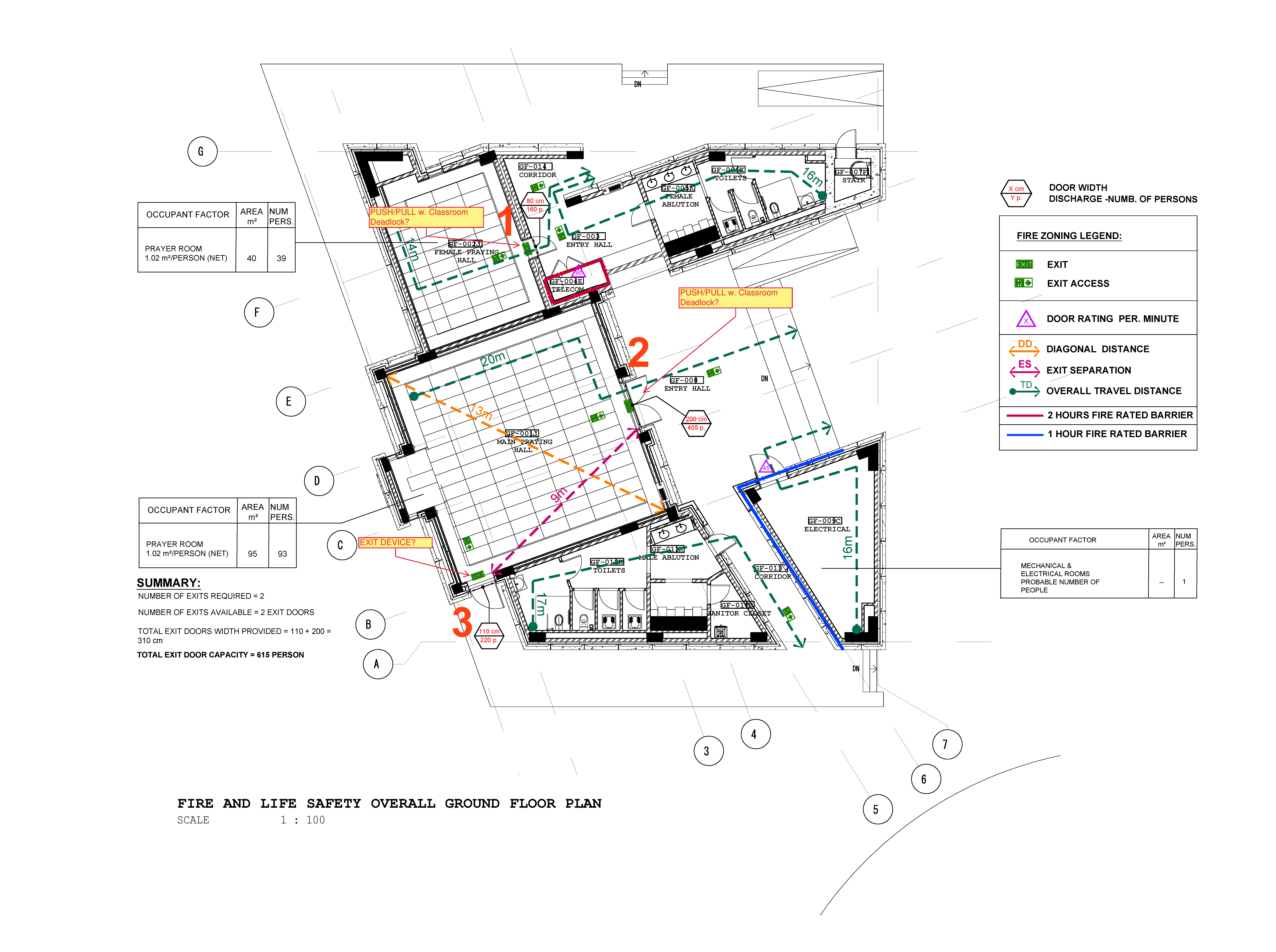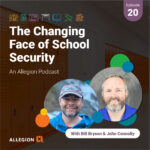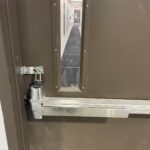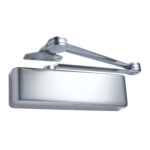On Tuesday I posted a partial floor plan, and I asked some questions to help you put what you have learned about codes to use. I think we could all benefit from the practice.
Spoiler Alert: If you want to look at the original post rather than skipping right to the answers (below), it is here.
Here’s the floor plan for a mosque that will be constructed in Dubai, and the exercise was to answer the questions below using NFPA 101 – Life Safety Code as well as the International Building Code (IBC).
Assuming that the adopted code is NFPA 101-2018 and the mosque is classified as an assembly occupancy…
1) Is Door 1 allowed to have push/pull hardware and a classroom function deadbolt (thumbturn retracts deadbolt but does not project it)? If yes, are there other criteria that would apply?
A mosque or church over a certain size (typically 50 occupants) would be considered an assembly occupancy, and doors serving assembly occupancies with an occupant load of 100 people or more are required by NFPA 101 to have panic hardware (if the door has a lock or latch).
According to the floor plan, the female praying room served by Door 1 has a calculated occupant load of 39 people. Because this door is not serving an area with an occupant load of 100 people or more, the door is not required by NFPA 101 to have panic hardware. In my interpretation, a thumbturn deadbolt and push/pull hardware would be allowed on this door since it is not a fire door assembly, as long as the deadbolt meets these requirements:
- The deadbolt must be the only locking/latching hardware on the door.
- The operable hardware must be mounted between 34-48 inches above the finished floor (AFF).
- The thumbturn must be operable with no tight grasping, pinching, or twisting of the wrist.
2) Is Door 2 allowed to have push/pull hardware and a classroom function deadbolt? What would be required for the inactive leaf?
Again, Door 2 is serving a room with an occupant load of less than 100 people, so NFPA 101 would not require panic hardware for these doors. A thumbturn deadbolt would be allowed if the criteria above were met. The inactive leaf could complicate the interpretation a bit, but typically the requirements of NFPA 101 apply to doors that are REQUIRED for egress (the IBC is a little different…more info below). Because the active leaf accommodates the occupant load of the main praying hall (93 people), most AHJs would not require the inactive leaf to comply with the requirements of NFPA 101. In that case, manual flush bolts would be allowed to secure the inactive leaf.
3) Is Door 3 required to have panic hardware? Could this door have a double-cylinder deadbolt instead?
Although NFPA 101 would not require Door 3 to have panic hardware because the occupant load of the room is less than 100 people, I like the idea of having panic hardware here. I can’t help but think of the 2019 tragedy at a mosque in Christchurch, New Zealand – panic hardware on the secondary egress door would have saved lives there. While the deadbolt on the main entrance to the main praying hall would have to be unlocked to allow people to enter the room, it’s possible that a deadbolt on the secondary exit could remain locked and could impede egress. A thumbturn deadbolt meeting the requirements above would be acceptable according to NFPA 101, but I would prefer to use panic hardware. Remember that AHJs can require something more restrictive than the adopted code if they believe that a hazard exists. A double-cylinder deadbolt (AKA key-operated lock) would not be allowed because the door is not the main exit.
How would the answers change if the adopted code was the 2018 International Building Code?
1) The IBC requires panic hardware for doors serving assembly occupancies with an occupant load of 50 people or more (if the door has a lock or latch). Door 1 is serving a room with an occupant load of less than 50 people, so this door could be equipped with push/pull hardware and a thumbturn deadbolt if the criteria in Answer 1 above were met.
2) Door 2 is serving a room with an occupant load of more than 49 people, so this door would be required by the IBC to have panic hardware (or the alternative below). Because the IBC requires doors provided for egress purposes to be code-compliant even if they are not needed in order to accommodate the occupant load, both leaves of the pair would typically have panic hardware.
An alternative to panic hardware would be a double-cylinder deadbolt (AKA key-operated lock). If this door is considered the “main door”, the IBC allows key-operated locks to be used if certain criteria are met. This application is allowed on the main door or doors in places of religious worship (as well as other occupancies). The lock must be readily distinguishable as locked, code-compliant signage is required, and the AHJ can revoke the use of a key-operated lock for due cause. Note that a thumbturn deadbolt would not be allowed by this section of the IBC – only a key-operated deadbolt.
If a key-operated lock is used on the active leaf of the pair, the inactive leaf would typically have manual flush bolts. However, the IBC does not specifically allow manual flush bolts on pairs serving assembly occupancies. With that said, automatic flush bolts and constant latching flush bolts would not be the best choice for this application, particularly if the push/pull hardware is not allowed on the door leaf with the automatic flush bolts. The AHJ would have to decide whether to allow the manual flush bolts or not.
3) The IBC would require Door 3 to have panic hardware because it is serving an occupant load of more than 49 people. A double-cylinder deadbolt would not be allowed because the door is not the main door of the building.
Complicated, right? If hardware was easy, they’d call it “EASY-ware”! 🙂
Do you have an idea for an “Apply-It” post? Please leave it in the reply box!
~~~
Here are some links in case you’d like more information about any of these topics:
- Decoded: Deadbolts in a Means of Egress
- Decoded: Key-Operated Locks
- Decoded: Flush Bolts and Coordinators
- Video: Flush Bolts and Coordinators
- Decoded: Panic Hardware Refresher
- Video: Where is panic hardware required by code?
You need to login or register to bookmark/favorite this content.







Very good exercise, especially for us that do not us 101 much.
I was wondering about the sign also,
“””Door 3 could receive a double cylinder deadbolt, so long as it has a sign stating that it is to remain unlocked during periods of occupancy. This is because it is low occupancy as well as a religious building.”””
But in reading 101 again , does not appear a sign is required.